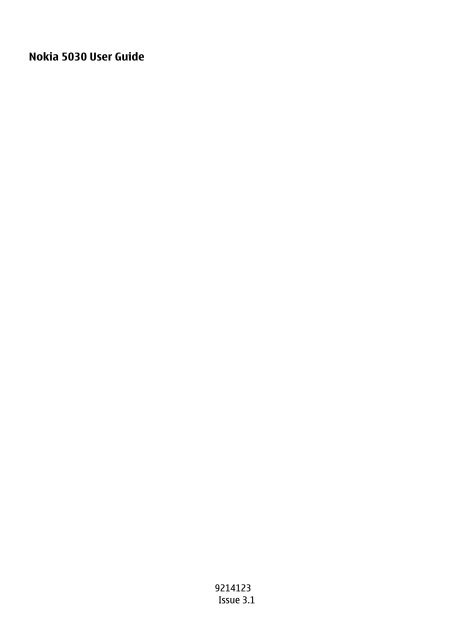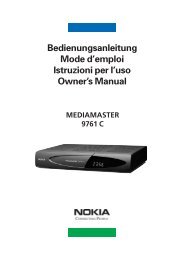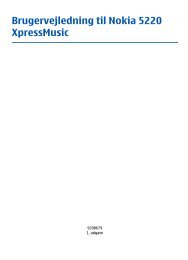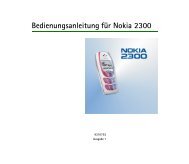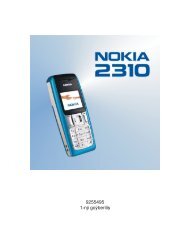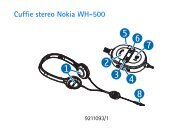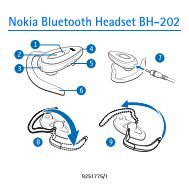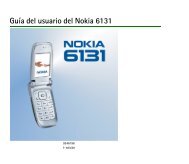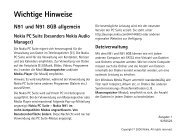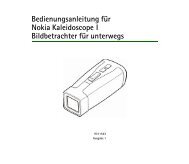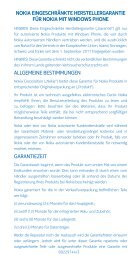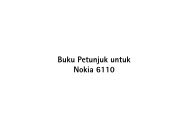PDF Nokia 5030 User Guide
PDF Nokia 5030 User Guide
PDF Nokia 5030 User Guide
Create successful ePaper yourself
Turn your PDF publications into a flip-book with our unique Google optimized e-Paper software.
<strong>Nokia</strong> <strong>5030</strong> <strong>User</strong> <strong>Guide</strong><br />
9214123<br />
Issue 3.1
2 Contents<br />
Contents<br />
Safety 3<br />
Get started 4<br />
Insert the SIM card and battery 4<br />
Remove the SIM card 4<br />
Charge the battery 4<br />
Switch on and off 5<br />
Your phone 5<br />
Keys and parts 5<br />
Main features 6<br />
Make and answer a call 6<br />
Write text 7<br />
Message 8<br />
Contacts 8<br />
Multi-phonebook 9<br />
Radio 9<br />
Turn the flashlight on or off 10<br />
General information 11<br />
Accessories 11<br />
Battery 11<br />
Battery and charger information 11<br />
Taking care of your device 12<br />
Recycle 13<br />
Additional safety information 13<br />
Small children 13<br />
Operating environment 13<br />
Medical devices 13<br />
Vehicles 14<br />
Potentially explosive environments 14<br />
Emergency calls 14<br />
Certification information (SAR) 14
Safety<br />
Read these simple guidelines. Not following them may be dangerous or illegal. Read<br />
the complete user guide for further information.<br />
SWITCH ON SAFELY<br />
Do not switch the device on when wireless phone use is prohibited or when<br />
it may cause interference or danger.<br />
ROAD SAFETY COMES FIRST<br />
Obey all local laws. Always keep your hands free to operate the vehicle while<br />
driving. Your first consideration while driving should be road safety.<br />
INTERFERENCE<br />
All wireless devices may be susceptible to interference, which could affect<br />
performance.<br />
SWITCH OFF IN RESTRICTED AREAS<br />
Follow any restrictions. Switch the device off in aircraft, near medical<br />
equipment, fuel, chemicals, or blasting areas.<br />
QUALIFIED SERVICE<br />
Only qualified personnel may install or repair this product.<br />
ACCESSORIES AND BATTERIES<br />
Use only approved accessories and batteries. Do not connect incompatible<br />
products.<br />
WATER-RESISTANCE<br />
Your device is not water-resistant. Keep it dry.<br />
Safety 3
4 Get started<br />
Get started<br />
Insert the SIM card and battery<br />
This phone is intended for use with the BL-5C battery.<br />
Safe removal. Always switch the device off and disconnect the charger before removing<br />
the battery.<br />
1 Press the release button (1) to release the back cover, and lift it (2). To remove the<br />
back cover, slide it upwards (3).<br />
2 Lift the battery, and remove it (4).<br />
3 Insert the SIM card (5). Ensure that the gold-coloured contact area is facing down<br />
and the bevelled corner of the SIM card is facing the bottom of the device.<br />
4 Replace the battery and back cover (6, 7, 8).<br />
Remove the SIM card<br />
Press the release spring (1), and slide out the SIM card (2).<br />
Charge the battery<br />
Your battery has been partially charged at the factory. If the device indicates a low<br />
charge, do the following:<br />
1 Connect the charger to a wall outlet.<br />
2 Connect the charger to the device.<br />
3 When the device indicates a full charge, disconnect the charger from the device,<br />
then from the wall outlet.
Tip: To save energy, unplug the charger when the battery is fully charged.<br />
You do not need to charge the battery for a specific length of time, and you can use the<br />
device while it is charging. If the battery is completely discharged, it may take several<br />
minutes before the charging indicator appears on the display or before any calls can be<br />
made.<br />
Switch on and off<br />
Press and hold the end key.<br />
Use the phone only in its normal operating position.<br />
Your device may have internal and external antennas. Avoid touching the antenna area<br />
unnecessarily while the antenna is transmitting or receiving. Contact with antennas<br />
affects the communication quality and may cause a higher power level during operation<br />
and may reduce the battery life.<br />
Your phone<br />
Keys and parts<br />
1 Earpiece<br />
2 Display<br />
3 Selection keys<br />
4 Navi key; hereafter referred<br />
to as scroll key<br />
5 Call key<br />
6 End/Power key<br />
7 Keypad<br />
Your phone 5
6 Your phone<br />
8 Release button<br />
9 Microphone<br />
10 Flashlight<br />
11 Wrist strap eyelet<br />
12 Channel selection keys<br />
13 FM radio key<br />
14 Headset connector<br />
15 Charger connector<br />
16 Loudspeaker<br />
Do not connect products that create an output signal as this may cause damage to the<br />
device. Do not connect any voltage source to the <strong>Nokia</strong> AV Connector.<br />
When connecting any external device or any headset, other than those approved by<br />
<strong>Nokia</strong> for use with this device, to the <strong>Nokia</strong> AV Connector, pay special attention to volume<br />
levels.<br />
Main features<br />
Select Menu and from the following:<br />
Messages — to create, send, open, and manage messages<br />
Contacts — to save names and phone numbers in the SIM card and phone memory<br />
Call register — to access phone numbers of missed, received, and dialled calls<br />
Settings — to set up various features of your phone<br />
Clock — to set the time for the alarm<br />
Radio — to manage radio features<br />
Reminders — to manage reminders<br />
Games — to set up game effects, or play the games installed in your phone<br />
Extras — to access various applications, such as the calculator or flashlight<br />
SIM services — to use additional services, if supported by your SIM card<br />
Make and answer a call<br />
Make a call<br />
Enter the phone number, including the country code and area code, if necessary, and<br />
press the call key.
Answer a call<br />
Press the call key.<br />
End or reject a call<br />
Press the end key.<br />
Use the loudspeaker or earpiece<br />
During a call, select Loudsp. or Hands..<br />
Adjust the volume<br />
During a call, scroll left or right to adjust the volume of the earpiece or headset.<br />
Warning:<br />
Continuous exposure to high volume may damage your hearing. Listen to music at a<br />
moderate level, and do not hold the device near your ear when the loudspeaker is in<br />
use.<br />
Write text<br />
Use traditional text input<br />
Press a key repeatedly until the desired letter is displayed.<br />
Activate predictive text input<br />
Select Options > Dictionary and the desired language.<br />
Deactivate predictive text input<br />
Select Options > Dictionary > Dictionary off.<br />
When using predictive text input, press each key once for a single letter. If the desired<br />
word is displayed, press 0, and start writing the next word. If ? is displayed after the<br />
word, the word is not in the dictionary.<br />
Change a word<br />
Press * repeatedly until the desired word is displayed.<br />
Add a word<br />
Select Spell, enter the word using traditional text input, and select OK.<br />
Add a space<br />
Press 0.<br />
Change text input method<br />
Press # repeatedly, and check the indicator at the top of the display.<br />
Your phone 7
8 Your phone<br />
Add a number<br />
Press and hold the desired number key.<br />
Add a special character<br />
Press * when using traditional text input; press and hold * when using predictive text<br />
input.<br />
Undo clearing of a message<br />
Select Options > Undo clear.<br />
Message<br />
The message services can only be used if they are supported by your service provider.<br />
Your device supports text messages beyond the limit for a single message. Longer<br />
messages are sent as two or more messages. Your service provider may charge<br />
accordingly. Characters with accents, other marks, or some language options take more<br />
space, and limit the number of characters that can be sent in a single message.<br />
Write and send a message<br />
1 Select Menu > Messages > Create message.<br />
2 Write the message. The message length indicator shows how many characters you<br />
can enter in the message.<br />
3 Select Options > Send, enter the recipient's phone number or select it from the<br />
contacts list, and select OK.<br />
Delete messages<br />
Select Menu > Messages > Delete messages > All read or the desired folder.<br />
Contacts<br />
You can save names and phone numbers in the phone and SIM card memory. The<br />
contacts list can contain up to 500 contacts, stored in the phone memory.<br />
Search for a contact<br />
Scroll down in the standby mode, enter the first characters or letters of the name, and<br />
scroll to the desired contact.<br />
Save contacts to the contacts list<br />
Select Menu > Contacts > Add contact.<br />
Copy contacts between the phone and SIM card memory<br />
Select Menu > Contacts > Copy.
Multi-phonebook<br />
Your phone supports up to five separate phonebooks for multiple users. When the multiphonebook<br />
is activated, only the contacts in the active phonebook are visible.<br />
A contact can belong to one or several phonebooks. The contacts in Shared contacts are<br />
accessible from all phonebooks.<br />
Select Menu > Contacts > Settings > Multi-Phonebook and the appropriate options.<br />
Activate the multi-phonebook<br />
Select Phonebook style > Multi-Phonebook.<br />
Activate a phonebook<br />
Select Current phonebook and the desired phonebook or Shared contacts.<br />
Assign a contact to one or more phonebooks<br />
Select Manage contacts and the desired contact.<br />
Rename a phonebook<br />
Select Rename phonebooks and the desired phonebook.<br />
Radio<br />
To open the radio, select Menu > Radio, or press the FM radio key.<br />
Select from the following:<br />
Switch off — Close the radio.<br />
Save channel — Save an active channel.<br />
Auto tuning — Tune radio channels automatically. To start automatic tuning, scroll up<br />
or down.<br />
Manual tuning — Tune radio channels manually. To change the frequency, scroll up<br />
or down.<br />
Set frequency — Enter a desired frequency.<br />
Delete channel — Delete a saved channel.<br />
Rename — Rename a saved channel.<br />
Clock radio — Manage clock radio features.<br />
Loudspeaker or Headset — Listen to the radio using the loudspeaker or a headset.<br />
To adjust the volume of the radio, scroll left or right.<br />
You may need a compatible headset for better reception of radio signals.<br />
Your phone 9
10 Your phone<br />
Warning:<br />
Continuous exposure to high volume may damage your hearing. Listen to music at a<br />
moderate level, and do not hold the device near your ear when the loudspeaker is in<br />
use.<br />
Turn the flashlight on or off<br />
Select Menu > Extras > Flashlight.
General information<br />
About your device<br />
The wireless device described in this guide is approved for<br />
use on the EGSM 900 and 1800 MHz networks. Contact your<br />
service provider for more information about networks.<br />
Your device may have preinstalled bookmarks and links for<br />
third-party internet sites and may allow you to access thirdparty<br />
sites. These are not affiliated with <strong>Nokia</strong>, and <strong>Nokia</strong><br />
does not endorse or assume liability for them. If you access<br />
such sites, take precautions for security or content.<br />
Warning:<br />
To use any features in this device, other than the alarm clock,<br />
the device must be switched on. Do not switch the device on<br />
when wireless device use may cause interference or danger.<br />
When using this device, obey all laws and respect local<br />
customs, privacy and legitimate rights of others, including<br />
copyrights. Copyright protection may prevent some images,<br />
music, and other content from being copied, modified, or<br />
transferred.<br />
Make back-up copies or keep a written record of all important<br />
information stored in your device.<br />
When connecting to any other device, read its user guide for<br />
detailed safety instructions. Do not connect incompatible<br />
products.<br />
The images in this guide may differ from your device display.<br />
Refer to the user guide for other important information about<br />
your device.<br />
Network services<br />
To use the device you must have service from a wireless<br />
service provider. Some features are not available on all<br />
networks; other features may require that you make specific<br />
arrangements with your service provider to use them.<br />
Network services involve transmission of data. Check with<br />
your service provider for details about fees in your home<br />
network and when roaming on other networks. Your service<br />
provider can explain what charges will apply.<br />
Your service provider may have requested that certain<br />
features be disabled or not activated in your device. If so,<br />
these features will not appear on your device menu. Your<br />
device may also have customized items such as menu names,<br />
menu order, and icons.<br />
Support<br />
When you want to learn more about how to use your product<br />
or you are unsure how your device should function, see the<br />
user guide or see the support pages at www.nokia.com/<br />
support or your local <strong>Nokia</strong> website, or with a mobile device,<br />
www.nokia.mobi/support.<br />
If this does not resolve your issue, do the following:<br />
• Restart the device: switch off the device, and remove<br />
the battery. After about a minute, replace the battery,<br />
and switch on the device.<br />
• Restore the original factory settings as explained in the<br />
user guide.<br />
If the issue remains unsolved, contact <strong>Nokia</strong> for repair<br />
options. See www.nokia.com/repair. Before sending your<br />
device for repair, always back up the data in your device.<br />
Accessories<br />
General information 11<br />
Warning:<br />
Use only batteries, chargers, and accessories approved by<br />
<strong>Nokia</strong> for use with this particular model. The use of any other<br />
types may invalidate any approval or warranty, and may be<br />
dangerous. In particular, use of unapproved chargers or<br />
batteries may present a risk of fire, explosion, leakage, or<br />
other hazard.<br />
For availability of approved accessories, please check with<br />
your dealer. When you disconnect the power cord of any<br />
accessory, grasp and pull the plug, not the cord.<br />
Battery<br />
Battery and charger information<br />
Your device is powered by a rechargeable battery. The battery<br />
intended for use with this device is BL-5C. <strong>Nokia</strong> may make<br />
additional battery models available for this device. This<br />
device is intended for use when supplied with power from<br />
the following chargers: AC-3. The exact charger model<br />
number may vary depending on the type of plug. The plug<br />
variant is identified by one of the following: E, EB, X, AR, U, A,<br />
C, K, or UB.<br />
The battery can be charged and discharged hundreds of<br />
times, but it will eventually wear out. When the talk and<br />
standby times are noticeably shorter than normal, replace the<br />
battery. Use only <strong>Nokia</strong> approved batteries, and recharge<br />
your battery only with <strong>Nokia</strong> approved chargers designated<br />
for this device.<br />
If a battery is being used for the first time or if the battery has<br />
not been used for a prolonged period, it may be necessary to<br />
connect the charger, then disconnect and reconnect it to<br />
begin charging the battery. If the battery is completely<br />
discharged, it may take several minutes before the charging<br />
indicator appears on the display or before any calls can be<br />
made.<br />
Safe removal. Always switch the device off and disconnect the<br />
charger before removing the battery.
12 Taking care of your device<br />
Proper charging. Unplug the charger from the electrical plug<br />
and the device when not in use. Do not leave a fully charged<br />
battery connected to a charger, since overcharging may<br />
shorten its lifetime. If left unused, a fully charged battery will<br />
lose its charge over time.<br />
Avoid extreme temperatures. Always try to keep the battery<br />
between 15°C and 25°C (59°F and 77°F). Extreme<br />
temperatures reduce the capacity and lifetime of the battery.<br />
A device with a hot or cold battery may not work temporarily.<br />
Battery performance is particularly limited in temperatures<br />
well below freezing.<br />
Do not short-circuit. Accidental short-circuiting can occur<br />
when a metallic object such as a coin, clip, or pen causes direct<br />
connection of the positive (+) and negative (-) terminals of<br />
the battery. (These look like metal strips on the battery.) This<br />
might happen, for example, when you carry a spare battery<br />
in your pocket or purse. Short-circuiting the terminals may<br />
damage the battery or the connecting object.<br />
Disposal. Do not dispose of batteries in a fire as they may<br />
explode. Dispose of batteries according to local regulations.<br />
Please recycle when possible. Do not dispose as household<br />
waste.<br />
Leak. Do not dismantle, cut, open, crush, bend, puncture, or<br />
shred cells or batteries. In the event of a battery leak, prevent<br />
battery liquid contact with skin or eyes. If this happens, flush<br />
the affected areas immediately with water, or seek medical<br />
help.<br />
Damage. Do not modify, remanufacture, attempt to insert<br />
foreign objects into the battery, or immerse or expose it to<br />
water or other liquids. Batteries may explode if damaged.<br />
Correct use. Use the battery only for its intended purpose.<br />
Improper battery use may result in a fire, explosion, or other<br />
hazard. If the device or battery is dropped, especially on a<br />
hard surface, and you believe the battery has been damaged,<br />
take it to a service centre for inspection before continuing to<br />
use it. Never use any charger or battery that is damaged. Keep<br />
your battery out of the reach of small children.<br />
Taking care of your device<br />
Your device is a product of superior design and craftsmanship<br />
and should be treated with care. The following suggestions<br />
will help you protect your warranty coverage.<br />
• Keep the device dry. Precipitation, humidity, and all<br />
types of liquids or moisture can contain minerals that<br />
will corrode electronic circuits. If your device does get<br />
wet, remove the battery, and allow the device to dry<br />
completely before replacing it.<br />
• Do not use or store the device in dusty, dirty areas. Its<br />
moving parts and electronic components can be<br />
damaged.<br />
• Do not store the device in high or cold temperature.<br />
High temperatures can shorten the life of electronic
devices, damage batteries, and warp or melt certain<br />
plastics. When the device warms to its normal<br />
temperature from a cold temperature, moisture can<br />
form inside the device and damage electronic circuit<br />
boards.<br />
• Do not attempt to open the device other than as<br />
instructed in this guide.<br />
• Do not drop, knock, or shake the device. Rough<br />
handling can break internal circuit boards and fine<br />
mechanics.<br />
• Do not use harsh chemicals, cleaning solvents, or strong<br />
detergents to clean the device. Only use a soft, clean,<br />
dry cloth to clean the surface of the device.<br />
• Do not paint the device. Paint can clog the moving parts<br />
and prevent proper operation.<br />
• Use only the supplied or an approved replacement<br />
antenna. Unauthorised antennas, modifications, or<br />
attachments could damage the device and may violate<br />
regulations governing radio devices.<br />
• Use chargers indoors.<br />
• Backup all data you want to keep, such as contacts and<br />
calendar notes.<br />
• To reset the device from time to time for optimum<br />
performance, power off the device and remove the<br />
battery.<br />
These suggestions apply equally to your device, battery,<br />
charger, or any accessory.<br />
Recycle<br />
Always return your used electronic products, batteries, and<br />
packaging materials to dedicated collection points. This way<br />
you help prevent uncontrolled waste disposal and promote<br />
the recycling of materials. Check product environmental<br />
information and how to recycle your <strong>Nokia</strong> products at<br />
www.nokia.com/werecycle, or nokia.mobi/werecycle.<br />
The crossed-out wheeled-bin symbol on your product,<br />
battery, literature, or packaging reminds you that all<br />
electrical and electronic products, batteries, and<br />
accumulators must be taken to separate collection at the end<br />
of their working life. This requirement applies in the<br />
European Union. Do not dispose of these products as unsorted<br />
municipal waste. For more environmental information, see<br />
the product Eco-Declarations at www.nokia.com/<br />
environment.<br />
Additional safety information<br />
The surface of this device is nickel-free.<br />
Additional safety information 13<br />
Small children<br />
Your device and its accessories are not toys. They may contain<br />
small parts. Keep them out of the reach of small children.<br />
Operating environment<br />
This device meets RF exposure guidelines in the normal use<br />
position at the ear or at least 2.2 centimetres (7/8 inch) away<br />
from the body. Any carry case, belt clip, or holder for bodyworn<br />
operation should not contain metal and should position<br />
the device the above-stated distance from your body.<br />
To send data files or messages requires a quality connection<br />
to the network. Data files or messages may be delayed until<br />
such a connection is available. Follow the separation distance<br />
instructions until the transmission is completed.<br />
Parts of the device are magnetic. Metallic materials may be<br />
attracted to the device. Do not place credit cards or other<br />
magnetic storage media near the device, because<br />
information stored on them may be erased.<br />
Medical devices<br />
Operation of radio transmitting equipment, including<br />
wireless phones, may interfere with the function of<br />
inadequately protected medical devices. Consult a physician<br />
or the manufacturer of the medical device to determine<br />
whether they are adequately shielded from external RF<br />
energy. Switch off your device when regulations posted<br />
instruct you to do so. Hospitals or health care facilities may<br />
use equipment sensitive to external RF energy.<br />
Implanted medical devices<br />
Manufacturers of medical devices recommend a minimum<br />
separation of 15.3 centimetres (6 inches) between a wireless<br />
device and an implanted medical device, such as a pacemaker<br />
or implanted cardioverter defibrillator, to avoid potential<br />
interference with the medical device. Persons who have such<br />
devices should:<br />
• Always keep the wireless device more than 15.3<br />
centimetres (6 inches) from the medical device.<br />
• Not carry the wireless device in a breast pocket.<br />
• Hold the wireless device to the ear opposite the medical<br />
device.<br />
• Turn the wireless device off if there is any reason to<br />
suspect that interference is taking place.<br />
• Follow the manufacturer directions for the implanted<br />
medical device.<br />
If you have any questions about using your wireless device<br />
with an implanted medical device, consult your health care<br />
provider.<br />
Hearing aids<br />
Some digital wireless devices may interfere with some<br />
hearing aids.
14 Additional safety information<br />
Vehicles<br />
RF signals may affect improperly installed or inadequately<br />
shielded electronic systems in motor vehicles such as<br />
electronic fuel injection, electronic antilock braking,<br />
electronic speed control, and air bag systems. For more<br />
information, check with the manufacturer of your vehicle or<br />
its equipment.<br />
Only qualified personnel should service the device or install<br />
the device in a vehicle. Faulty installation or service may be<br />
dangerous and may invalidate your warranty. Check regularly<br />
that all wireless device equipment in your vehicle is mounted<br />
and operating properly. Do not store or carry flammable<br />
liquids, gases, or explosive materials in the same<br />
compartment as the device, its parts, or accessories.<br />
Remember that air bags inflate with great force. Do not place<br />
your device or accessories in the air bag deployment area.<br />
Switch off your device before boarding an aircraft. The use of<br />
wireless teledevices in an aircraft may be dangerous to the<br />
operation of the aircraft and may be illegal.<br />
Potentially explosive environments<br />
Switch off your device in any area with a potentially explosive<br />
atmosphere. Obey all posted instructions. Sparks in such<br />
areas could cause an explosion or fire resulting in bodily<br />
injury or death. Switch off the device at refuelling points such<br />
as near gas pumps at service stations. Observe restrictions in<br />
fuel depots, storage, and distribution areas; chemical plants;<br />
or where blasting operations are in progress. Areas with a<br />
potentially explosive atmosphere are often, but not always,<br />
clearly marked. They include areas where you would be<br />
advised to turn off your vehicle engine, below deck on boats,<br />
chemical transfer or storage facilities and where the air<br />
contains chemicals or particles such as grain, dust, or metal<br />
powders. You should check with the manufacturers of<br />
vehicles using liquefied petroleum gas (such as propane or<br />
butane) to determine if this device can be safely used in their<br />
vicinity.<br />
Emergency calls<br />
Important: This device operates using radio signals,<br />
wireless networks, landline networks, and user-programmed<br />
functions. If your device supports voice calls over the internet<br />
(internet calls), activate both the internet calls and the<br />
cellular phone. The device may attempt to make emergency<br />
calls over both the cellular networks and through your<br />
internet call provider if both are activated. Connections in all<br />
conditions cannot be guaranteed. You should never rely<br />
solely on any wireless device for essential communications<br />
like medical emergencies.<br />
To make an emergency call:<br />
1 If the device is not on, switch it on. Check for adequate<br />
signal strength. Depending on your device, you may<br />
also need to complete the following:<br />
• Insert a SIM card if your device uses one.<br />
• Remove certain call restrictions you have<br />
activated in your device.<br />
• Change your profile from Offline or Flight profile<br />
to an active profile.<br />
2 Press the end key as many times as needed to clear the<br />
display and ready the device for calls.<br />
3 Enter the official emergency number for your present<br />
location. Emergency numbers vary by location.<br />
4 Press the call key.<br />
When making an emergency call, give all the necessary<br />
information as accurately as possible. Your wireless device<br />
may be the only means of communication at the scene of an<br />
accident. Do not end the call until given permission to do so.<br />
Certification information (SAR)<br />
This mobile device meets guidelines for exposure to<br />
radio waves.<br />
Your mobile device is a radio transmitter and receiver. It is<br />
designed not to exceed the limits for exposure to radio waves<br />
recommended by international guidelines. These guidelines<br />
were developed by the independent scientific organisation<br />
ICNIRP and include safety margins designed to assure the<br />
protection of all persons, regardless of age and health.<br />
The exposure guidelines for mobile devices employ a unit of<br />
measurement known as the Specific Absorption Rate or SAR.<br />
The SAR limit stated in the ICNIRP guidelines is 2.0 watts/<br />
kilogram (W/kg) averaged over 10 grams of tissue. Tests for<br />
SAR are conducted using standard operating positions with<br />
the device transmitting at its highest certified power level in<br />
all tested frequency bands. The actual SAR level of an<br />
operating device can be below the maximum value because<br />
the device is designed to use only the power required to reach<br />
the network. That amount changes depending on a number<br />
of factors such as how close you are to a network base station.<br />
The highest SAR value under the ICNIRP guidelines for use of<br />
the device at the ear is 1.06 W/kg.<br />
Use of device accessories may result in different SAR values.<br />
SAR values may vary depending on national reporting and<br />
testing requirements and the network band. Additional SAR<br />
information may be provided under product information at<br />
www.nokia.com.
DECLARATION OF CONFORMITY<br />
Hereby, NOKIA CORPORATION declares that this RM-524<br />
product is in compliance with the essential requirements and<br />
other relevant provisions of Directive 1999/5/EC. A copy of the<br />
Declaration of Conformity can be found at http://<br />
www.nokia.com/phones/declaration_of_conformity/.<br />
© 2009 <strong>Nokia</strong>. All rights reserved.<br />
<strong>Nokia</strong>, <strong>Nokia</strong> Connecting People, and Navi are trademarks or<br />
registered trademarks of <strong>Nokia</strong> Corporation. <strong>Nokia</strong> tune is a<br />
sound mark of <strong>Nokia</strong> Corporation. Other product and<br />
company names mentioned herein may be trademarks or<br />
tradenames of their respective owners.<br />
Reproduction, transfer, distribution, or storage of part or all<br />
of the contents in this document in any form without the prior<br />
written permission of <strong>Nokia</strong> is prohibited. <strong>Nokia</strong> operates a<br />
policy of continuous development. <strong>Nokia</strong> reserves the right<br />
to make changes and improvements to any of the products<br />
described in this document without prior notice.<br />
TO THE MAXIMUM EXTENT PERMITTED BY APPLICABLE LAW,<br />
UNDER NO CIRCUMSTANCES SHALL NOKIA OR ANY OF ITS<br />
LICENSORS BE RESPONSIBLE FOR ANY LOSS OF DATA OR INCOME<br />
OR ANY SPECIAL, INCIDENTAL, CONSEQUENTIAL OR INDIRECT<br />
DAMAGES HOWSOEVER CAUSED.<br />
THE CONTENTS OF THIS DOCUMENT ARE PROVIDED "AS IS".<br />
EXCEPT AS REQUIRED BY APPLICABLE LAW, NO WARRANTIES OF<br />
ANY KIND, EITHER EXPRESS OR IMPLIED, INCLUDING, BUT NOT<br />
LIMITED TO, THE IMPLIED WARRANTIES OF MERCHANTABILITY<br />
AND FITNESS FOR A PARTICULAR PURPOSE, ARE MADE IN<br />
RELATION TO THE ACCURACY, RELIABILITY OR CONTENTS OF THIS<br />
DOCUMENT. NOKIA RESERVES THE RIGHT TO REVISE THIS<br />
DOCUMENT OR WITHDRAW IT AT ANY TIME WITHOUT PRIOR<br />
NOTICE.<br />
The availability of particular products and applications and<br />
services for these products may vary by region. Please check<br />
with your <strong>Nokia</strong> dealer for details and availability of language<br />
options. This device may contain commodities, technology or<br />
software subject to export laws and regulations from the US<br />
and other countries. Diversion contrary to law is prohibited.<br />
9214123/Issue 3.1 EN<br />
15


